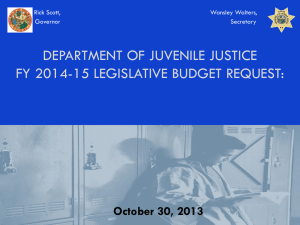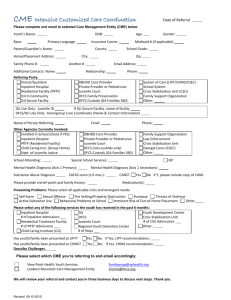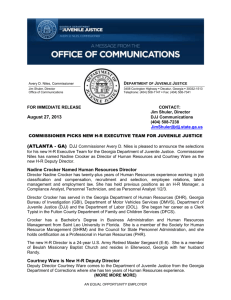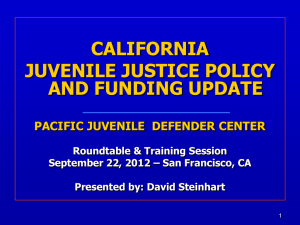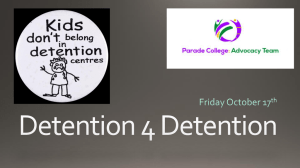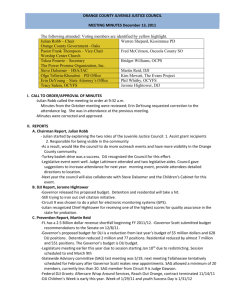Alaska Department of Juvenile Justice - 101
advertisement
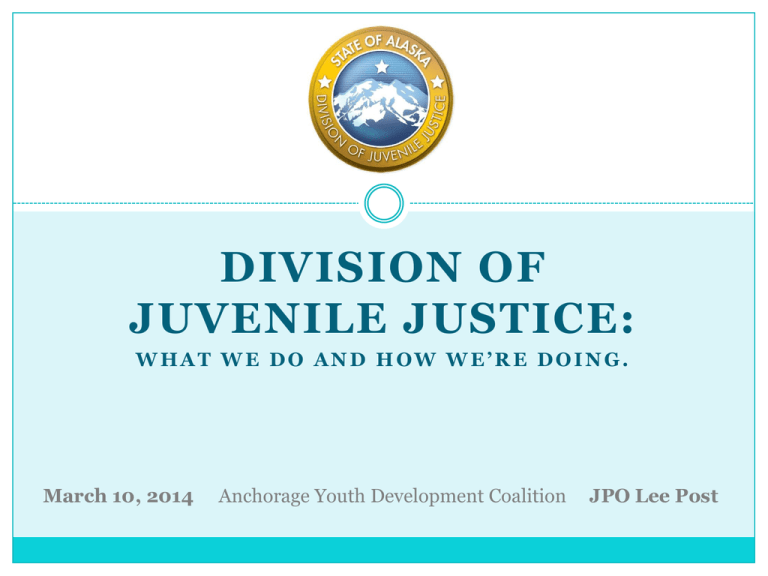
DIVISION OF JUVENILE JUSTICE: WHAT WE DO AND HOW WE’RE DOING. March 10, 2014 Anchorage Youth Development Coalition JPO Lee Post Juvenile Probation Core Values Alaska Division of Juvenile Justice DJJ’s Mission Hold juvenile offenders accountable for their behavior. Promote the safety and restoration of victims and communities. Assist offenders and their families in developing skills to prevent crime. Restorative Justice and DJJ’s Mission The Balancing Act of Restorative Justice Priorities Hold Juveniles accountable for their behavior. Restorative Justice Assist offenders and their families in developing skills to prevent crime. Promote the safety and restoration of victims and communities. Restorative Justice The questions behind balancing the different priorities: What harm was done? What can be done to repair the harm? Who is responsible to repair the harm? Restorative Justice The responsibility is shared by DJJ, the youth, the youth’s family, the victim, and the community. Juvenile Justice vs. the Adult System Juvenile Justice does not use determinant sentencing or assign fines based on a specific offense, unlike the adult criminal system. Consequences for juveniles are individually assigned based in part on: Age The nature of the offense Referral history Response to prior DJJ intervention Intake Interview (at the diversion level) Demonstrated need for services Least Restrictive Response DJJ looks for the least restrictive response that meets our mission and the goals of Restorative Justice. o o o o o o Detention Diversion Alternatives Court Intervention Treatment Disposition Recommendations Placement Graduated Responses An incremental response to the minor’s criminal referrals and behavior, good or bad. o More restrictive consequences in response to new criminal referrals and behavioral issues. o Incentives to assist a juvenile in meeting her or her goals. Graduated Responses Institutional Treatment Residential Treatment Formal Probation Adjudication Held-in-Abeyance 2 Diversion Agreement Adjust with Conference 1 3 4 5 6 Results-Based Accountability Goals DJJ is focused on improving success in five areas: 1. Improve the overall success of DJJ involved youth and decrease overall recidivism 2. Improve outcomes for Alaska Native youth 3. Increase educational and employment success in DJJ youth 4. Improve outcomes for DJJ youth with behavioral health issues 5. Reduce the risk of substance abuse for DJJ youth Division of Juvenile Justice Core Services Probation Treatment Detention Three Components of DJJ Juvenile Probation – 16 Probation Offices receive police referrals and supervises youth on probation (intake and supervision) Youth Facilities – There are 8 Detention Facilities and 4 Treatment facilities throughout Alaska. State Office – Manages grants, provides training and programming. 16 Probation DJJ Probation Offices Kenai Fairbanks McLaughlin Nome Juneau Palmer Bethel Ketchikan Juvenile Probation Anchorage Juvenile Probation Unit D Probation Outreach Intake Investigation Court Services Probation Case Management Community Outreach Supervision Intake Investigation • Screening • Interview • Referral for services • Victim impact • Diversion, Adjustment • Formal Response Court Services • Delinquency Petition • Court Reports and Appearances • Department of Law collaboration • Victim Services Case Management • Risk and Needs Assessment • Treatment Planning • Referral for services • Placement • Transitional services Supervision • Assessments • Juvenile Community Supervision • Connect Juveniles to services • Interstate compact Community Outreach • School involvement • Prevention services • Community Presentations and Education Most Progressed Disposition FY13(n=3462 ) In Process 4% Dismissed 19% Petitioned - Adjudicated 17% Petitioned 10% Diverted* 51% Referrals by Type FY13 (n=3462) Other*, 9% Drug & Alcohol, 13% Against Persons, 19% PV/CV, 18% Against Property, 41% Informal Adjustment Many youth, if not the majority of youth that are referred to DJJ are not taken to court. DJJ attempts to resolve the issue with the youth, parent and victim without involving the court. This can include paying for damages, writing letters of apology, being referred to services, such as substance abuse, counseling, community programs, etc. We are often looking for community programs where we can refer youth. Community Referrals Youth Court Community Detention Tribal Programs Step-Up (with ASD) Victim / Offender Mediation Parenting with Love and Mental Health Services Substance Abuse Services Girls Circle Aggression Replacement Training Vocational Training Community Work Service Limits [PLL] Transition to Independence Program [TIP] Alaska Military Youth Academy Other community programs. Detention and Treatment Services Probation Treatment Detention DJJ Detention and Treatment Facilities Provides confinement and rehabilitation of juvenile offenders as determined by the court. Detention Units: Designed for short-term secure units for youth awaiting court hearings. Treatment Units: Designed for youth who have been ordered by the courts into long-term secure treatment due to the serious and/or chronic nature of their offenses. Detention Operations Crisis Stabilization Detention Skill Development Detention Services Education Operations Crisis Stabilization • Health Assessment & Services • Mental Health and Suicide screenings • Behavioral Health Intervention • Safety & Security Detention Services • Admissions • Court • Family Involvement Education • Maintain educational progress • Math & Reading Skills Skill Development • Life Skills Development • Social Skills Development • Substance Abuse Education • Victim Impact Classes Treatment Operations Treatment Services Treatment Transitional Services Education Skill Development Operations Treatment Services • Assessment • Cultural • Clinical • Crisis intervention • Strengthening Families • Case Management • Visitation Education • High School diploma • GED • Math & Reading Skills Skill Development • Aggression Replacement Training • Vocational training • Cultural competency • Substance Abuse Treatment • Victim Impact Classes) Transitional Services • Case Planning • Community Supervision • Reassessment • Referral services Demographics, Numbers and Statistics for FY 2013 McLaughlin Youth Center Boys Detention Anchorage, AK Probation Trends Statewide Unduplicated Juvenile Count, Delinquency Referrals and Offenses FY 2003 - FY 2013 12,000 11,708 10,000 8,000 7,466 6,000 5,655 5,143 4,000 3,462 2,000 2,462 0 FY03 FY04 FY05 FY06 Offenses FY07 FY08 Referrals FY09 FY10 Unique Juveniles FY11 FY12 FY13 Statewide Detention Facility Admissions FY 2003 - FY 2013 2,600 2,484 2,400 2,200 1,972 2,000 1,972 1,985 2,030 1,802 1,800 1,600 1,675 1,724 1,527 1,516 1,323 1,400 1,170 1,200 1,101 1,154 1,170 1,189 1,078 956 1,000 963 861 800 785 700 600 400 200 0 FY03 FY04 FY05 FY06 FY07 Admission Records FY08 FY09 FY10 Unduplicated Juveniles** FY11 FY12 FY13 Facility Average Daily Population FY 2003 - FY 2013 180 160 140 161 139 120 TX 100 90 79 80 60 40 20 0 FY03 FY04 FY05 FY06 FY07 FY08 FY09 FY10 FY11 FY12 FY13 DET 155 160 140 120 149 149 145 139 134 129 121 121 126 125 130 116 107 112 100 106 92 86 96 80 79 83 66 60 40 Statewide Treatment Facility Admissions FY 2003 - FY 2013 20 0 FY03 FY04 FY05 FY06 FY07 Admission Records FY08 FY09 FY10 Unduplicated Juveniles** FY11 FY12 FY13 THANK YOU . PLEASE CONTACT ME WITH ANY QUESTIONS: LEE POST Anchorage Juvenile Probation Supervisor (907) 261-4527 lee.post@alaska.gov

